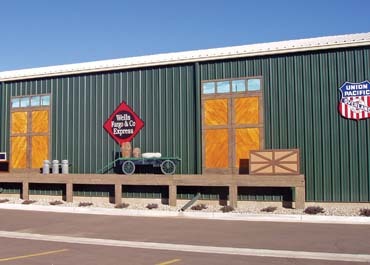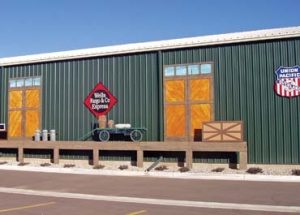Business Management
Track Your Profits
Railroad history pays off for a history buff.
Published
18 years agoon

In 2005, we had the rare privilege of designing and fabricating a sign system for a new museum. The Greeley Freight Station, the brainchild of retired newspaper publisher Dave Trussell, depicts a century of typical U.S. railroading via working, HO-scale models and museum displays.
This job was tailor-made for Kent. His grandfather had worked for the Denver and Rio Grande Railroad (D&RGRR). Kent taught high-school and university-level history before opting for self-employment. His first published book was a biographical study of a Colorado-homestead family. And, his HO-scale, model-railroad layout will be the focal point of the library in our new house.
Naturally, he was excited about this project, and, naturally, I was afraid he would underbid the job to get it. We began the bidding process in February 2004, and we completed the project in February 2006. During the two years, we completed eight work orders, and each turned a profit. Such a rewarding job reminds us why Kent chose to return to signmaking full time, but we always welcome a consistent profit, too.
A COH-scale project
We completed the first work order, a simple 2 x 20-ft. Alumalite aluminum-composite-material (Laminators Inc., Hatfield, PA) identification sign with computer-generated letters, as soon as the building was ready for occupancy. The total sale price, $867.50, minus $168.02 in materials, left a $699.48 contribution to overhead (COH). We used materials that replicate, but are more durable than, those used in 1916. Like staging a theatrical set, this museum invited the public to experience the grandeur of the U.S. rail system.
The second assignment, an 18 x 24-in. dedication plaque, proved equally simple. We printed the plaque in gold-medal foil on black vinyl to accommodate 223 words. Kent also provided, at $20 each, four, used, gooseneck light fixtures. The sale price, $215, minus $11.42 in materials, resulted in a $203.58 COH.
Then, the real fun began. Greeley discourages metal buildings. The local zoning code requires such buildings to be "enhanced" by architectural elements. The city’s modern metal buildings often imitate the earlier century’s vertical-slat, clap-wood structures. A deep-green paint coat enhanced this building’s appearance.
Still, the city wanted more defined "elements." The Development Code specifically states paint alone won’t meet the qualifications. So, Kent researched that era’s buildings and how we could, without exceeding budget, reproduce the effect.
AdvertisementThe third job, invoiced for $1,206.24, includes faux finishing three walk doors and signs for the Yard Office, Railway Express and Adams Express buildings, plus research and layout that also applied to the fourth project, a dimensional mural. Kent charged $250 for research and design, a small fraction of the real value.
Luckily, Kent knew about trains and where to quickly find information — Kent’s a member of the National Railway Historical Society and Colorado Rail Road Historical Foundation. Of course, we could only count time he recorded.
The three, small signs totaled $269.24, minus $14.96 in materials, which yielded $254.28 COH. The faux finish for the three walk doors (priced at $697) entailed only 51 cents of material, but we needed 6 hours to create the effect. This resulted in a $105.61 COH per hour (CpH).
Eleven months elapsed between the early rendition of the faux walk doors and the remainder of the dimensional mural. This allowed sufficient time to complete the research, order necessary materials, schedule subcontractors and pin down estimates.
We decided the exterior mural would depict the 1916, fictional, Greeley Freight Station dock. Always very thorough, Kent even painted the transoms added above the doors to reflect 1916 telegraph poles, and he incorporated names of Greeley residents from that era on the crates.
We saved time and money by stocking pictorial oil color. We often purchase supplies from retiring signshops and other sources, well below market price, simply because they’ll no longer use the material. When we buy the material, we generally don’t know when it’ll come in handy. We bought the pictorial oil color in 1992, and it’s been stored for 13 years. Luckily, oil color lasts forever.
AdvertisementThe completed project for the fourth (and major) job was prepped, cut, painted, installed, and clearcoated, then finally invoiced on July 15, 2005, for $6,955.75. It includes two "freight doors" complete with transoms created on Econolite aluminum-composite panel (also from Laminators) and attached to the side of the building, additional transoms above the walk doors (which were also finished at this time) and steel cutouts (produced by Magnolia River Co. and invoiced independently), which were painted to represent crates, a dock, a freight wagon and sundries. These "faux creations" were installed in dimensional planes to enhance the effect.
We had hired Ft. Collins, CO-based Dan Seese for his expertise as a second mural artist and locally based Elk River Enterprises to assist with the installation, but the job totaled only $2,338.96, leaving a $4,616.79 COH. This covered 44 hours at our $105 hourly quote, or 71 hours at our $65 average (after adding unexpected hours). Our break-even point (for overhead only) was 96 hours. Kent clocked a total of 58 hours on this job, so we walked away netting $1,444.29, or $24.58 per costable hour.
The very simple table cards and the schedule board resulted in a COH of $154.21 and $135.77 per job, respectively.
In early 2006, Kent added six heralds to the building’s walls. These signs were part of the original mural concept, but three paperwork hurdles stood in the way. By November, Trussell had selected the specific heralds to display, which included the D&RGRR herald that Kent’s grandfather had originally designed.
Here’s the catch: We had to ask each railroad for permission to use its herald. Of the six, two logos are owned by the museum. Great Western Railroad, still independent, granted immediate permission. Union Pacific, however, owns the other three heralds, including the D&RGRR’s. Corporate authorization took an additional 2 months; we couldn’t complete the job until January 2006.
We apparently faced the third hurdle well. Greeley approved the signs as an architectural element and requested we add the two, museum-owned heralds, which we did in February, when we finally completed the two-year commitment.
AdvertisementOnce the jobs were completed, I calculated our gain (or loss). This customer brought us $11,854.42 of business during two years. After our out-of-pocket costs, we retained $8,711.03. I attach overhead to every costable hour of labor clocked on a timesheet, whether for an employee or owner.
Our overhead increased in 2005, because we bought new equipment and faced skyrocketing utility costs. Although we’ve minimized overhead this year, we will use the same rate until year end.
Subtracting the $6,457.68 costable overhead from the COH, we discovered a $2,253.35 net for 123.18 hours of Kent’s time. This amounts to $18.29 per costable hour.
Forty-nine percent of Kent’s time isn’t billable and must be covered by the net. This makes his income a mere $9.33 per hour — and less, if you consider my time as well. By the same token, doctors don’t keep what they charge, either. By doing this job, Kent created a new face in the community and a link to our nation’s history. But it’s also nice when such aesthetically gratifying jobs turn out to be financially successful as well.
|
Sales and Costing |
|||||
| Date begun | Date completed | Description | Sale | Costs | COH |
| 3/29/2004 | 4/6/2004 | ID sign | $867.50 | $168.02 | $699.48 |
| 5/20/2004 | 7/7/2004 | Dedication | $215.00 | $11.42 | $203.58 |
| 3/29/2004 | 8/7/2004 | Railway signs Faux doors Research and design |
$269.24 $687.00 $250.00 |
$14.96 $0.51 $0.00 |
$254.28 $686.49 $250.00 |
| 2/9/2005 | 7/15/2005 | Dimensional murals | $6,955.75 | $2,338.96 | $4,616.79 |
| 8/4/2005 | 8/12/2005 | Table cards | $199.50 | $45.29 | $154.21 |
| 8/15/2005 | 9/13/2005 | Schedule board | $142.50 | $6.73 | $135.77 |
| 8/15/2005 | 1/24/2006 | 4 5-ft. railroad heralds | $1,686.56 | $479.75 | $1,206.81 |
| 1/19/2006 | 2/13/2006 | 2 3-ft. museum heralds | $581.37 | $77.75 | $503.62 |
|
Overhead Calculation |
||||
| Year | OWNhrs | EMPhrs | Rate | OH |
| 2004 | 35.92 | 0.08 | $46.24 | $1,664.64 |
| 2005 | 72.85 | 0.25 | $54.00 | $3,947.40 |
| 2006 | 14.41 | 1.25 | $54.00 | $845.64 |
|
Overhead and Profit |
|
|
Sales |
$11,854.42 |
|
Costs |
$3,143.39 |
|
COH |
$8,711.03 |
|
OH |
$6,457.68 |
|
Net |
$2,253.35 |
|
Owner hours |
123.18 |
|
Net per hour |
$18.29 |

SPONSORED VIDEO
Introducing the Sign Industry Podcast
The Sign Industry Podcast is a platform for every sign person out there — from the old-timers who bent neon and hand-lettered boats to those venturing into new technologies — we want to get their stories out for everyone to hear. Come join us and listen to stories, learn tricks or techniques, and get insights of what’s to come. We are the world’s second oldest profession. The folks who started the world’s oldest profession needed a sign.
You may like

NUtec Digital Ink Invests in Solar Energy for Facility

5 Reasons to Sell a Sign Company Plus 6 Options

21 Larry Albright Plasma Globes, Crackle Tubes and More
Subscribe

Bulletins
Get the most important news and business ideas from Signs of the Times magazine's news bulletin.
Most Popular
-

 Tip Sheet2 weeks ago
Tip Sheet2 weeks agoAlways Brand Yourself and Wear Fewer Hats — Two of April’s Sign Tips
-

 Photo Gallery4 days ago
Photo Gallery4 days ago30 Snapshots of the 2024 ISA Sign Expo
-

 Ask Signs of the Times6 days ago
Ask Signs of the Times6 days agoWhy Are Signs from Canva so Overloaded and Similar?
-

 Real Deal2 weeks ago
Real Deal2 weeks agoA Woman Sign Company Owner Confronts a Sexist Wholesaler
-

 Paula Fargo1 day ago
Paula Fargo1 day ago5 Reasons to Sell a Sign Company Plus 6 Options
-

 Benchmarks1 week ago
Benchmarks1 week ago6 Sports Venue Signs Deserving a Standing Ovation
-

 Photo Gallery1 day ago
Photo Gallery1 day ago21 Larry Albright Plasma Globes, Crackle Tubes and More
-

 Women in Signs2 weeks ago
Women in Signs2 weeks ago2024 Women in Signs: Megan Bradley











